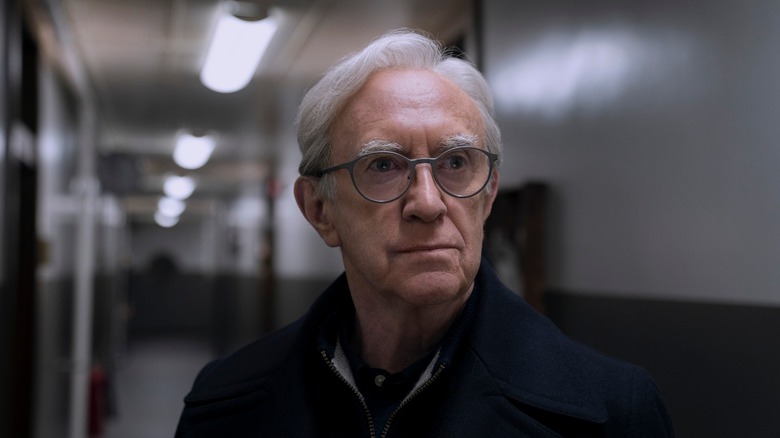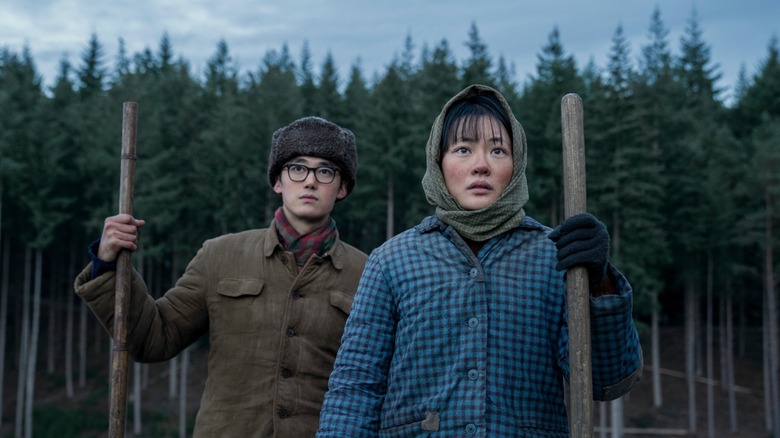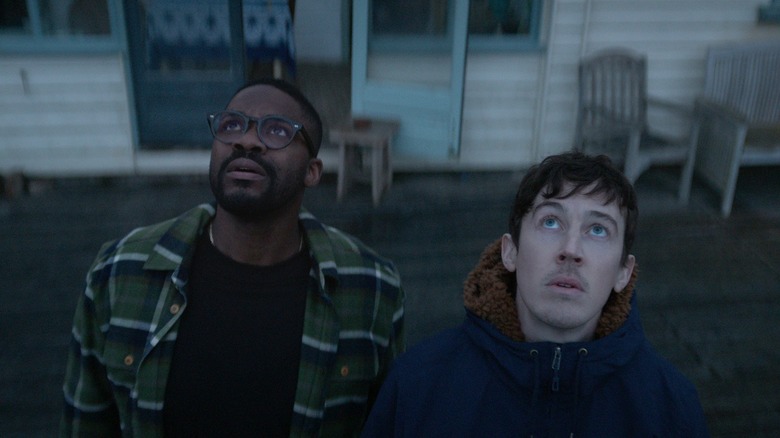The Aliens In 3 Body Problem Have A Point: Their Motivation Explained
This post contains spoilers for Netflix's "3 Body Problem."
Netflix's new series "3 Body Problem" has a lot going for it. There's the intriguing, multi-layered sci-fi premise that's pulled straight from Liu Cixin's popular novel of the same name. There's an intriguing ensemble cast that includes "Game of Thrones" MVPs like John Bradley and Liam Cunningham along with the likes of Benedict Wong and breakout star Jess Hong. Perhaps most importantly for viewers committing their hard-won time to the series, there are several entertaining and disturbing mysteries at the heart of "3 Body Problem," from scientists dying by suicide after mental countdown clocks show up in their brains to a mysterious invisible woman who's just as likely to kill our heroes as she is to offer them a smoke.
By the end of the show's eight-episode first season, "3 Body Problem" does offer some solid answers to our questions. The countdown clocks, invisible stranger, string of murders and suicides, and several other strange occurrences all come courtesy of the San-Ti, a race of aliens that's already on its way to colonize Earth. Unlike other alien invasion stories, though, "3 Body Problem" meticulously lays the groundwork for us to understand the San-Ti and the context of their mission before we begin to fear them. By season's end, you would be forgiven for thinking that the San-Ti kind of have a point.
A dying planet
The San-Ti attempt to communicate their needs to humankind in a strangely roundabout yet ultimately effective way, creating a highly advanced video game-style simulation that they gift to the world's leading scientists. Their goal is to help the scientists understand where they're coming from, and it's Jin (Hong) who finally figures out what's going on by completing every level. The San-Ti, it seems, are a group of otherworldly beings whose planet is beholden to a three-body system, meaning it has two suns and is prone to changing orbit. This makes the planet more susceptible to "chaotic eras," including ice ages, warming periods, and dangerous changes in gravity.
All of this is unsustainable for the San-Ti, so they set out in search of a new home. They received a message from Earth — sent by China's super-satellite — with a personalized addition from political exile turned scientist Ye Wenjie (Zine Tseng). When Ye, jaded by her experiences during the Cultural Revolution, requests that the San-Ti come and take over Earth, the entity she's speaking with notes that Earth will be conquered and discourages her from sending a follow-up message. She chooses to reply anyway, welcoming the change in regime, so the San-Ti head out on a 400-plus-year mission toward our solar system.
As far as we can tell up to this point, the San-Ti are a group of individuals looking for a home like anyone else. Unlike human colonizers, however, they asked permission before setting out to Earth, and initially even tried to forge an alliance with those who weren't scared of them. When the relationship between humans and the San-Ti went south, it was entirely humankind's fault.
Learning to lie
The turning point in the relationship between aliens and Earthlings arrives somewhat arbitrarily. An oil tycoon who's spent much of his adult life devoted to the San-Ti finally figured out how to speak with them quickly despite the vast distances between planets. With religious reverence, he attempted to prepare the path for their arrival on Earth by introducing them to human culture — including stories. After Evans (Jonathan Pryce) read the San-Ti a version of "The Big Bad Wolf," their relationship soured as the aliens began to realize the vast difference between the two groups.
The San-Ti, it turns out, use a sort of groupthink that allows them a certain unity — their world is supposedly grounded in honesty. The aliens didn't know that humans could lie, and when Mike Evans tells them, it opens up a whole new world of frightening possibilities for the visitors. Are they headed toward a trap? Will humans manipulate and control them, or even torture or kill them? Imagine if the first time you ever learned that people who seem safe can hurt you was only after your entire culture had already given up its homeland based on the promise of those seemingly nice people. It's a jarring shift that motivates the San-Ti to begin showing their power, scaring Earthlings and declaring them "bugs" (a metaphor they learned from Evans himself).
Judgment Day
Sure, the San-Ti and their representatives commit violence before the communication breakdown, but it's all done in the name of keeping themselves and their allies — the cult-like group of followers who want to ensure they're welcomed upon arrival — safe. The countdown clocks, for example, aren't meant to kill scientists so much as kill science itself to prevent an attack on them. When the San-Ti does kill someone, they send a mysterious, seemingly human woman (Marlo Kelly) who seems to put her own menacing spin on what appear to be simple execution assignments.
Meanwhile, the show's most gruesome show of force — the total, slow-motion destruction of the ship Judgement Day — is signed off on by humans with a casualness that shows that the San-Ti are right to worry about the motivations of their future hosts. People kill people all the time, and they'd no doubt kill aliens too if they had the chance. The San-Ti first attempt to contact humans peacefully (via their satellite response, video game explainer, and calm discussions with the cult leaders) before they're prompted to start playing the offensive. Thomas Wade's (Cunningham) group, meanwhile, seems to be emblematic of a kill-first, ask-questions-later government that never seems to have been open to talking to the San-Ti in the first place.
Puny humans
Of course, there is a chance the San-Ti themselves are lying. The initial message Ye received in 1977 contained a sense of individuality that contrasted against the San-Ti's later explanation that they basically have a collaborative brain. "I am a pacifist in this world," the being that made first contact with Earth explained. "You are lucky that I am the first to receive your message. I am warning you: do not answer. If you answer, we will come." The distinct use of "I" and "we" here seems to hint that one San-Ti member could lie or keep a secret from another, something their representative told Evans they didn't know how to do.
If the San-Ti really are ruthless conquerors who simply pretended to play nice, "3 Body Problem" still hasn't convinced me to root for the humans. The series has a lot of interesting qualities going for it, but strong characterization isn't one of them. Most of the central characters are defined by a single trait — Auggie's principles, Jin's determination, Saul's sense of philosophy, Will's selflessness, Raj's conformity — but it's not enough to make them particularly sympathetic or even especially real-feeling. Other characters, like Ye, Wade, and Da Shi (Wong), range from extremely cynical about humankind to actively Team San-Ti.
At its best, "3 Body Problem" accomplishes a sweeping sense of existential dread; its unsolvable, god-like central problem reminds me of the excellent HBO series "The Leftovers," yet "3 Body Problem" conveys none of that show's blunt emotions or deep sense of humanity. Despite ample time devoted to backstory, the humans are mostly left as half-filled sketches, while the aliens make their own right to live known clearly through profound simulations and honest expressions of fear. Whether or not it meant to, the first season of "3 Body Problem" has left me rooting for the aliens.




